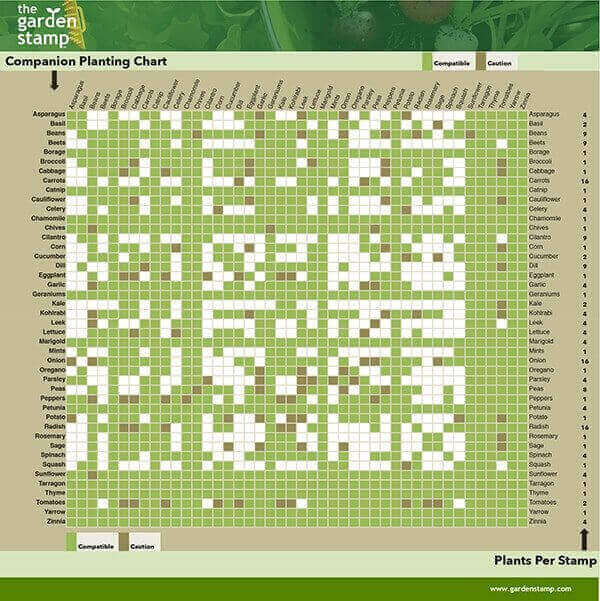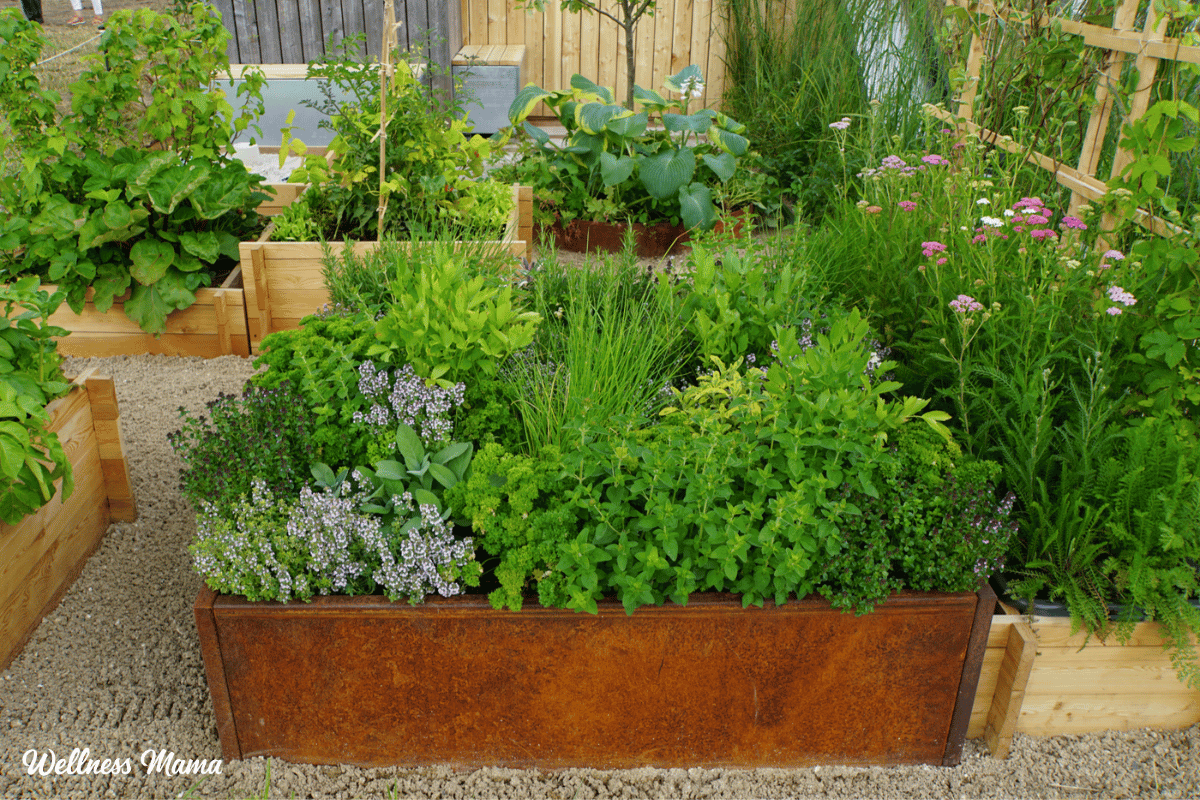Just about every organic gardening book or blog advocates for companion planting. I’ve even written before about plant pairs that control pests in the garden and boost plant health. Sounds perfect, right?
Companion Planting Chart
So, you start picking out what you want to grow in your garden this year. Next, you search “companion planting chart” on Google. Then you get a few results that look something like this (courtesy of the Garden Stamp):

After studying multiple conflicting charts (with the help of a magnifying glass maybe), you eventually figure out a plan (you think). Then you eagerly start planting your organic garden.
But you realize… the tomatoes are right by the potatoes (and the chart says they don’t get along!). Once the peas are done you won’t be able to put in beans because they’re right by the garlic. The chart assures you that will be a disaster!
Sigh… Gardening was supposed to be fun, right?
So what’s an organic gardener to do? And is companion planting really worth all the hassle?
Companion Planting: Helpful or Hype?
Countless gardening experts swear by the practice and have written whole books on the subject. Yet, many horticultural experts consider companion planting gardens “folklore” rather than science.
It’s true that many of today’s recommended plant pairings are not confirmed by formal scientific studies. Most plant associations came to be through historical observation. As in Farmer Joe observed his crops came in better when tomatoes and eggplants were planted in alternate rows).
Also, a series of “sensitive crystallization” studies on plant pairings in the 1960s left a stain on the theory of companion planting. The mainstream scientific community rejected this method and its findings as pseudo-science. The goal was to discover which plants “liked” each other. The researchers looked at crystal formations left after the evaporation of plant extracts mixed with various solutions.
The Science of Companion Planting
Some of the most highly regarded horticultural organizations in the U.S. promote companion planting. Within limits of course. Cornell University points out companion planting’s long history.
Naturalists have known about these properties of plants for thousands of years. For example, about 2,000 years ago the Roman agriculturalist, Varro, declared “Large walnut trees close by, make the border of the farm sterile.” Chemicals in oak leaves retard the development of insects that feed on them… Alfalfa and clover enrich the soil with nitrogen that they capture from the air. Certain trees move groundwater to the soil surface where shallow-rooted plants can grow even under droughty conditions. Groups of plants which grow well together are called “companions.
Experts argue that companion planting seems to work for so many because of this “yin and yang” relationship found in nature. The idea isn’t to plant the same crop in a large area (picture the typical cornfield). Gardeners see improvement when they imitate the diversity found in the natural world. This means alternating rows with a complementary crop, or planting different plants together.
Intercropping
This theory of non-competition between plants with differing needs is now called “intercropping.” It’s also gained widespread acceptance in mainstream agriculture. Deep-rooted plants can grow with shallow, or tall plants with low-growing ones that need shade. Plants in the same space with different needs have less competition.
Unlike the lore of companion planting, intercropping has been shown to work on a home garden scale. Originating in tropical climates like Africa, understanding the niches plants grow in and how you can combine them together in limited space and resources has a long history. Intercropping has three major advantages: 1) Reduces physical space needed 2) Reduces potential for widespread crop failure since a pest or disease is unlikely to decimate both crops 3) Can reduce resource use like water and fertilization needs.
Call it what you will, how can you apply the theory to your backyard garden?
Best Companion Plants
Here are a few companion plants to give you a general idea of the process.
Corn – Goes well with pole beans, cucumbers, dill, melons, peas, squash, and sunflowers. Leafy greens like Swiss chard grow well in the shade of corn.
Cabbage – Likes Brussels sprouts, broccoli, cauliflower, kale, kohlrabi, and turnips.
Beets – Does well with brassicas (like Brussels sprouts and the cabbage family), legumes (like bush beans), garlic, lettuce, and the onion family.
Carrots – Good companions include chives, leeks, onions, peas, radishes, rosemary, and sage.
Zucchini – Oregano and zinnias attract pollinators for zucchini.
Fennel – Said not to go well with anything so should be planted on its own.
Planting Guide for Pest Control
Covering plants with nets helps to protect against pests like cabbage worms and Japanese beetles. Interplanting your veggies with certain herbs and flowers can deter bad bugs and attract beneficial ones. I like peppering my raised beds with plants like catnip, chamomile, coriander, and chervil.
Here are a few different plants to try in your vegetable garden.
- Cilantro – Helps repel pests like aphids, spider mites, and potato beetles.
- Nasturtium – Helps squash plants have fewer squash bugs. They’re also a good trap crop for radishes and repel insects like aphids and whiteflies. It’s edible and makes a gorgeous addition to a salad.
- Marigold – Attract beneficial insects. They’re a good one to grow with the onion family since they help with onion maggot flies.
- Borage – Repels garden pests like hornworms on tomato plants. It also attracts pollinator bees and beneficial wasps. Plus it’s edible and a medicinal herb.
- Tansy – Helps with ants, cutworms, beetle infestations, and cucumber beetles. and Colorado potato beetles. Attracts beneficial insects.
- Calendula – Helps with Colorado potato beetles and root nematodes. It also makes a great skin salve!
- Mint – Flea beetles, aphids, and ants. Try it in tea as well.
- Alyssum – attracts hoverflies that eat aphids, and attracts pollinators.
- Sage – Along with rosemary repels carrot flies. Helps protect against cabbage moth damage.
- Chives – Help with aphids, mites, and flies.
K.I.S.S.: Keep It Simple, Sister!
Understanding why companion planting works removes the need for complicated charts. Knowing the goal, you can relax and enjoy the grand experiment of gardening!
1. Go for Diversity
Imitate nature. Experiment with breaking away from uniform rows of the same crop in a concentrated area. Intersperse carrots and onions, for example, or plant basil under tomatoes.
Add flowers to attract pollinators and helpful predators like wasps and ladybugs. Add herbs to confuse pests with a variety of scents. Use fast-growing lettuces and radishes as a living mulch around slow-growing plants like tomatoes and cabbages.
Constantly replenish bare patches left after mature plants are harvested. Late in the season, choose sections of the garden to “rest.” You can grow nitrogen-boosting field peas or clover to till into the soil the following spring.
One traditional planting method is to plant corn, beans, and squash together. The beans can climb the corn like a trellis, while the wide squash leaves shade the plant’s roots. This trio is called the three sisters in Indigenous American culture.
2. Use the Rule of Opposites (Complementarity)
With a little research (and better yet hands-on experience over the years), you can get to know which plants are shallow-rooted and which are deep-rooted. Which plants are heavy feeders or light feeders. And which are slow-growing or fast-growing. As a general rule, pair these together.
Here’s another example of opposites at work. Plant climbing vines like pole beans with tall, sturdy plants. These provide a vertical structure, like sunflowers. Double duty!
3. Keep it in the Family
Learn your plant families and keep related plants together in the same area of the garden. Related plants generally get along (with a few exceptions) and have similar needs and pest threats. This way you only have to learn the needs of each family instead of each individual plant.
While this may not seem like the best way to create a diverse garden, working with family plants simplifies companion planting. With just a few notes for reference, you’ll know facts like:
- Which pests favor that family. For example, the infamous Colorado potato beetle likes the potato, tomato, eggplant, and pepper family.
- How much water and fertilizer each family needs
- Which companion plants might deter pests for that family section. And which ones attract beneficial insects.
This approach also makes crop rotation a snap! When the time comes for succession planting, you can easily rotate the family neighborhoods. This way you don’t sap the soil or encourage pests in one spot.
There are a few exceptions to every rule. Never put your potatoes near your tomatoes, even though they’re in the same family! Want to learn more about this concept? I recommend the book Great Garden Companions.
4. Garden, Hope, and Don’t Worry!
More than anything, don’t worry too much about the list of dos and don’ts. Generally, companion planting won’t make or break your garden. Taken in the right direction though, it contributes to a healthy biosystem.
Be willing to learn about your plants’ general characteristics. Observe, experiment, and record the results for next year’s planning. You’ll quickly build a hands-on experience that far outweighs the knowledge any book could give you. Soon you’ll be companion planting with confidence!
Do you use companion planting in your garden? What’s worked for you? Hand on your gardening wisdom by sharing your tips!


Leave a Reply